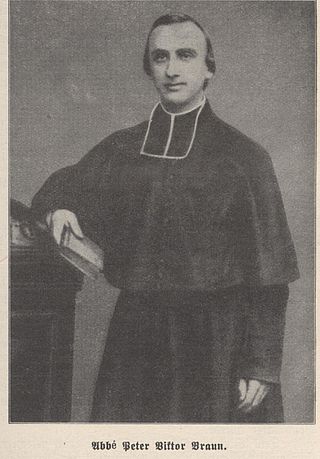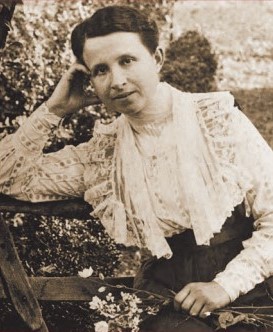
Anne Thérèse Guérin, designated by the Vatican as Saint Theodora, was a French-American saint and the foundress of the Sisters of Providence of Saint Mary-of-the-Woods, a congregation of Catholic sisters at Saint Mary-of-the-Woods, Indiana. Pope John Paul II beatified Guérin on 25 October 1998, and Pope Benedict XVI canonized her a saint of the Catholic Church on 15 October 2006. Mother Guérin's feast day is 3 October, although some calendars list it in the Roman Martyrology as 14 May, her day of death.
Jacques-François Dujarié (1767-1838) was a French Catholic priest who served the people of France at the start of the 19th century. To this end, he founded a congregation of Religious Sisters and another one of Brothers.
The Third Order of Saint Francis is a third order in the Franciscan tradition of Christianity, founded by the medieval Italian Catholic friar Francis of Assisi.

The Sisters of the Infant Jesus, also known as the Dames of Saint Maur, are a religious institute of the Catholic Church originating from Paris, France and dedicated to teaching.

The Congregation of Divine Providence is a Catholic religious institute of women that was founded in 1851 in the Grand Duchy of Hesse by Wilhelm Emmanuel von Ketteler, Bishop of Mainz, together with Stephanie Fredericke Amalie de la Roche von Starkenfels (1812–1857), a French noblewoman. The congregation was formally recognized by the Holy See on 16 July 1935.
The Sisters of St. Joseph of Saint-Marc are a Roman Catholic congregation of religious sisters, based in the town of Saint-Marc, Alsace, France.

Vigy is a commune in the Moselle department in Grand Est in north-eastern France.

The Religious of Jesus and Mary, abbreviated as R.J.M., form a Roman Catholic religious congregation of women dedicated to the education and service of the poor. It was founded at Lyon, France, in October 1818, by Claudine Thévenet.

Jean-Martin Moye was a French Catholic priest who served as a missionary in China and was the founder of the Sisters of the Congregation of Divine Providence. He also organized the first expression of consecrated life among the women of China. He was beatified by the Catholic Church in 1954.

The Sisters of Providence of Saint Mary-of-the-Woods are an apostolic congregation of Catholic women founded by Saint Theodora Guerin at Saint Mary-of-the-Woods, Indiana, in 1840. Mother Theodore and her five companion sisters departed from the Sisters of Providence of Ruillé-sur-Loir, France, at the invitation of the Bishop of Vincennes, Indiana, to found the Sisters of Providence in the United States. In 1843, the Indiana congregation became independent of the religious institute in Ruillé, and the Rules of the Congregation were approved by the Holy See in 1887.
The Sisters of St. Anne (S.S.A.) is a Roman Catholic religious institute, founded in 1850 in Vaudreuil, Quebec, Canada, by the Blessed Marie Anne Blondin, S.S.A., to promote the education of the rural children of the Province of Canada. Their vision is rooted and guided by Ignatian spirituality.
Sisters of Providence may refer to a number of congregations of Religious Sisters:
The Sisters of Providence of Ruillé-sur-Loir or the Sœurs de la Providence de Ruillé-sur-Loir, France, are a congregation of Roman Catholic Religious Sisters founded in 1806 by Jacques-Francois Dujarié.
The Sisters of Providence of the Institute of Charity, more commonly called the Rosminian Sisters of Providence, are a Roman Catholic religious institute for women founded in Italy in 1832.
The Sisters Servants of the Sacred Heart are a French religious congregation founded in 1866. They currently serve throughout France and Africa. According to their current Superior General, Sister Danièle, their service consists of "serving the Sacred Heart of Jesus through responding to the needs of world wherever they find themselves."

The Servant of God, Abbé Pierre-Victor Braun, was a French Catholic priest who ministered to the poor of Paris. His work laid the foundations for the establishment of several different congregations of Religious Sisters who now serve worldwide. The cause for his canonization was opened in France in 1991, and was accepted for investigation by the Holy See in 2007.
The Sisters of the Christian Doctrine of Nancy (D.C.) is a religious order of the Roman Catholic Church for women, whose primary mission is the teaching and nursing of the poor. Its members place after their names the order's initials, D.C. They are known as the "Vatelottines" in honor of their founder, and also "School Sisters", especially in Germany and Luxembourg, because of their primary mission. They should not be confused with the Spanish order of the Sisters of the Christian Doctrine (Mislata), which was founded in 1880.
The Missionary Catechists of Divine Providence are a religious institute of Catholic women founded in 1930 in the United States to serve the spiritual and social needs of the Mexican-American community there. They are engaged in religious ministry, in social service, and in diocesan and parish leadership positions in the Southwestern United States. They were the first religious congregation established to serve the needs of that population, and continue to do so through catechesis and social work among predominantly-Hispanic communities.
Louise Feltin was an American Roman Catholic sister from Alsatia and the founder of the Sisters of Divine Providence in Texas. She is the co-founder of the first Catholic school in Texas. Feltin's work in the parish schools "heavily influenced the course of parochial education" in Texas.

Marie-Eugénie Caps (1892-1931) was a French Catholic sister who founded the Congregation of the Missionary Sisters of the Holy Spirit or Spiritaines or Spiritan Sisters in January 1921, at the age of 28.









